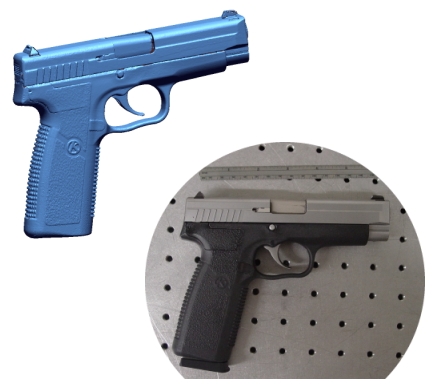
Scanned and delivered: Replica gun sales boosted 25%

NVision’s laser scanning service is helping Soft Air USA get its replica airsoft guns to market much faster, boosting sales significantly. The CAD model (top) produced by NVision’s laser scanning is used to create the most accurate replica (bottom) possible.
Soft Air USA, Inc. has reduced the time required to get its licensed replica airsoft guns to market by four to six weeks by using NVision’s laser scanning service bureau to reverse engineer the real guns.
The real guns can’t be shipped to Asia, where the replicas are manufactured, so in the past the manufacturers would travel to the U.S. to make silicone molds of the "pieces." Now, NVision’s laser scanning service bureau uses laser scanning to produce a computer aided design (CAD) file of the gun’s geometry. “Laser scanning helps us get our guns to market faster, which typically results in a 25% increase in the revenues generated by each product,” says John Steele, president of Soft Air USA.
Soft Air USA is a subsidiary of Cybergun S.A., a leading manufacturer of replica airsoft guns. Airsoft guns fire 6-mm plastic balls using a low-power spring, CO2, gas, or electric force designed to avoid the potential for injury. Many of the Soft Air USA products are used by the military and law enforcement for training exercises. Soft Air USA has licenses from gun manufacturers such as Smith & Wesson, Colt, Sig Sauer, IMI (Uzi), Mauser, Thompson, and Kalishnikov.
The company uses contract manufacturers located in Asia to build the airsoft guns. Regulations in both the U.S. and the Asian countries make it virtually impossible to ship the guns to Asia. So in the past, the contract manufacturers would send people to the U.S. to make silicone casts of the guns. They took the casts back to Asia and used them as models to make injection molds to produce the replica airsoft guns.
More recently, Soft Air USA has been using NVision’s service bureau to make laser scans of the guns. Laser scanning works by projecting a line of laser light onto the surfaces to be measured, while a camera continuously triangulates the changing distance and profile of the laser line as it sweeps along. A computer translates the video image of the line into accurate 3D coordinates of the geometry of the object being scanned. NVision technicians create a point cloud consisting of millions of points and then use special software to automatically generate a surface model of the part through the point cloud. The resulting CAD file is provided to Soft Air USA.
The CAD model produced by laser scanning incorporates every detail of the prototype geometry,” Steele says. “The result is a much more accurate replica than we were ever able to produce using silicone molds. Even more important is the time savings, which helps us get to market faster and generate higher revenues for each product. We have been very pleased with the accuracy, cost, and lead time of NVision’s laser scanning services. They make it easy and cost effective to take advantage of the advantages of laser scanning without making any capital investment.”
Want more information? Click below.
NVision
© Nelson Publishing, Inc. All Rights Reserved